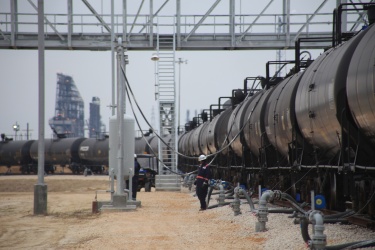
| December 16, 2013 | |
Energy & Environment: Beaumont, San Diego, Pacific Northwest
![]() Print this Article | Send to Colleague
Print this Article | Send to Colleague
The Port of Beaumont received its first rail unit trainshipment of crude oil. The board of commissioners of the Port of San Diego has adopted a Climate Action Plan to reduce greenhouse gas (GHG) emissions on port district tidelands. The ports of Seattle, Tacoma and Metro Vancouver aim to cut diesel emissions by 75 percent per ton of cargo moved by 2015 and 80 percent by 2020, from a 2005 baseline.
Beaumont Facility Receives First Crude Oil Unit Train
Jefferson Energy Companies received its first unit train of crude oil Wednesday, December 11 at its newly constructed Jefferson Transload Railport facility at the Port of Beaumont. The shipment of crude oil originated from the Niobrara shale oil fields in Colorado and was sold to a major local refinery in the Beaumont/Port Arthur area.
The first unit train had 70 rail cars with a total capacity of 43,000 barrels. The unit train was delivered by Union Pacific Railroad to the Jefferson Transload Railport. The facility is unique is capable of receiving trains from across the United States and Canada via each of the three major Class 1 rail carriers: Union Pacific, BNSF and Kansas City Southern.
The Jefferson Transload Railport was built with 120 rail car unloading stations to streamline source-to-refiner crude oil transport to Gulf Coast refiners. The facility will be expanded next year to accommodate heavy Canadian crude known as "bitumen."

Crude oil laden tank cars line the track at the Jefferson Transload Railport at the Port of Beaumont.
Photo/Port of Beaumont
San Diego Adopts Climate Action Plan
The board of commissioners of the Port of San Diego has adopted a Climate Action Plan to reduce greenhouse gas (GHG) emissions on port district tidelands. The plan passed unanimously on Tuesday, December 10.
The Port of San Diego Climate Action Plan will be used to provide a long-term and strategic vision for sustainability covering the port district’s five member cities (San Diego, Coronado, Chula Vista, National City and Imperial Beach), as well as its tenant businesses.
"By adopting a Climate Action Plan, the Port of San Diego continues to demonstrate its commitment to the environment as a steward of San Diego Bay," said Port Board Chair Ann Moore. "The Climate Action Plan will guide us in further reducing our environmental impact for years to come by managing energy and water use, and reducing waste, on our San Diego waterfront."
In June 2012, the board made a key policy decision by setting GHG reduction goals for District tidelands. The goals, which use 2006 emissions as a baseline, are:
- 10% reduction by 2020
- 25% reduction by 2035
The Climate Action Plan identifies these six GHG emission reduction categories:
- Transportation and land use
- Energy conservation and efficiency
- Alternative energy generation
- Water conservation and recycling
- Waste reduction and recycling
- Miscellaneous, including education.
The board, with input from the public and stakeholders, developed policies within each emissions category to provide guidance on implementation of the plan. Supporting those policies are more than 60 measures that will help the port reduce its GHG emissions.
The port already has 19 of those measures in place. Some examples are:
- The port's Green Business Network, in which 79 port's tenant businesses learn sustainable business practices with help from San Diego Gas & Electric.
- Shore power for cruise ships which also reduces diesel emissions.
- A Clean Truck Policy on port maritime terminals.
- Solar panels and retrofitted lighting around port facilities.
Each year, with a more comprehensive look every three years, the board will measure the effectiveness of the plan. The first comprehensive review will be conducted in 2015 to evaluate 2014 emissions.
The Climate Action Plan will be included in other integrated planning efforts at the port district.
Northwest Ports Set Goals to Further Cut Diesel Emissions by 2015
The ports of Seattle, Tacoma and Metro Vancouver aim to cut diesel emissions by 75 percent per ton of cargo moved by 2015 and 80 percent by 2020, from a 2005 baseline. Factoring in projected cargo growth, this, say the ports, will result in overall reductions of 70 percent by 2015 and 75 percent by 2020.
The ports also set a goal to reduce greenhouse gases by 10 percent by 2015 and 15 percent by 2020 per ton of cargo moved.
The goals are part of the 2013 Northwest Ports Clean Air Strategy Update, which was adopted last week. This update to the 2007 Northwest Ports Clean Air Strategy is a five-year-old partnership among the three ports and five regulatory agencies, along with cooperative relationships with customers, tenants, shipping lines and environmental organizations. The 2013 Update commits these groups to work together through 2020.
The 2013 update was based on the results of the 2011 Puget Sound Maritime Air Emissions Inventory. The inventory found maritime-related air pollution has decreased since 2005, with much of the progress due to significant, voluntary investments of the maritime industry and government agencies in cleaner technology, cleaner fuels and more efficient systems of operation.
To develop and implement the 2007 strategy and this 2013 strategy update, the three ports partnered with other government agencies in the Puget Sound: the U.S. Environmental Protection Agency, Washington State Department of Ecology and Puget Sound Clean Air Agency.
The strategy creates an integrated approach to improve air quality and reduce port-related emissions in the shared airshed to safeguard public health and the environment while supporting economic growth.
